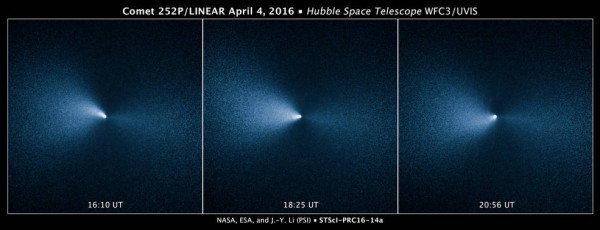Hubble Captures Spinning Comet From Its Closest Approach of Earth
| Ana Verayo | | May 15, 2016 05:31 AM EDT |
(Photo : NASA, ESA, and J.-Y. Li (Planetary Science Institute)) Comet 252P/LINEAR as it passed by Earth
NASA's Hubble Space Telescope just captured a series of incredible images of comet LINEAR or 252P, two weeks after its closest approach to Earth last March 21.
Comet 252P was estimated to be at a distance of at least 3 million miles away from the planet when it zipped by our backyard, but it also became one of the closest comets to pass by Earth. Apart from the moon, this comet is also the closest cosmic object that Hubble ever obtained observations from.
Like Us on Facebook
According to Hubble's lead scientist Jian-Yang Li, in order to obtain accurate measurements regarding the size of comets, these celestial objects need to be close enough. Since comets are about a few kilometers in diameter, LINEAR is expected to be less than one kilometer wide. Li adds that comet 252P is one of the smallest comets they have ever detected.
These photographs were captured on April 4 as comet LINEAR was speeding away from Earth at a distance of 8.7 million miles. Hubble mission scientists were eager to take advantage of this close approach of the comet, reaching a very high spatial resolution for the space telescope at 1.6 kilometers per pixel. Li also says that this is also the highest resolution that Hubble ever obtained from any comet, where ground observations only produced 10 times lower resolution compared to Hubble. Time lapse frames were also captured within 30 to 50 minute intervals.
The comet's bright glow appears to be rotating in a very similar manner as a lighthouse beam, as its bright light and tail are mostly made from jets of dust forming into emissions as the comet orbits closer to the sun. This process is known as sublimation, where comets similar to LINEAR that are composed of a core known as a nucleus is filled with primordial ice, dirt and dust, releasing jets known as a coma, that has been activated by the sun's heat.
The team's mission is not only to study this diminutive comet but to also observe how comets shrink in size as they achieve their closest approach to the sun, providing pivotal clues about these ancient remnants of the early solar system.
Tagshubble, Hubble Space Telescope, comet LINEAR, comet 252P, comets, NASA
©2015 Chinatopix All rights reserved. Do not reproduce without permission
EDITOR'S PICKS
-

Did the Trump administration just announce plans for a trade war with ‘hostile’ China and Russia?
-

US Senate passes Taiwan travel bill slammed by China
-

As Yan Sihong’s family grieves, here are other Chinese students who went missing abroad. Some have never been found
-

Beijing blasts Western critics who ‘smear China’ with the term sharp power
-

China Envoy Seeks to Defuse Tensions With U.S. as a Trade War Brews
-

Singapore's Deputy PM Provides Bitcoin Vote of Confidence Amid China's Blanket Bans
-

China warns investors over risks in overseas virtual currency trading
-

Chinese government most trustworthy: survey
-

Kashima Antlers On Course For Back-To-Back Titles
MOST POPULAR
LATEST NEWS
Zhou Yongkang: China's Former Security Chief Sentenced to Life in Prison

China's former Chief of the Ministry of Public Security, Zhou Yongkang, has been given a life sentence after he was found guilty of abusing his office, bribery and deliberately ... Full Article
TRENDING STORY

China Pork Prices Expected to Stabilize As The Supplies Recover

Elephone P9000 Smartphone is now on Sale on Amazon India

There's a Big Chance Cliffhangers Won't Still Be Resolved When Grey's Anatomy Season 13 Returns

Supreme Court Ruled on Samsung vs Apple Dispute for Patent Infringement

Microsoft Surface Pro 5 Rumors and Release Date: What is the Latest?










